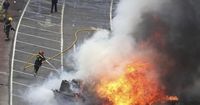Tragedy struck Mexico City last week when a tanker truck carrying propane exploded on a major highway, sending shockwaves through the capital and leaving a community reeling. As of Monday, September 15, 2025, the official death toll had risen to 15, according to Mexico City health officials, with dozens more still fighting for their lives in local hospitals.
The incident, which unfolded on Wednesday, September 10, 2025, has become one of the most devastating transportation disasters in recent memory for the city. The explosion and ensuing fire engulfed more than two dozen vehicles, leaving a trail of destruction and badly burned victims in its wake. The full human cost is still coming into focus as authorities continue their investigation and families wait anxiously for news of their loved ones.
On the morning of September 15, health officials took to X (formerly Twitter) to announce the passing of a 40-year-old man who had succumbed to his injuries. Just hours later, a somber statement from the same office confirmed the death of a 15th victim, whose identity had not yet been established. The number of hospitalized victims remained staggering: thirty-nine people were still under medical care as of Monday, many with severe burns and trauma.
The explosion, which occurred on a major artery in the bustling metropolis, was triggered when the tanker truck’s trailer overturned and ruptured after colliding with an object on the roadway. According to the Associated Press, investigators have determined that the rupture of the tank was the immediate cause of the catastrophic blast. The resulting inferno swept through the congested highway, catching dozens of vehicles in its path and creating a scene of chaos and panic.
Eyewitnesses described a terrifying sequence of events. Within moments of the collision, flames shot skyward, and thick black smoke billowed over the highway. Drivers abandoned their vehicles, some running for their lives as the fire spread rapidly. First responders arrived quickly, but the scale of the disaster was overwhelming. Firefighters battled the blaze for hours, while paramedics worked frantically to tend to the injured and transport the most critical patients to nearby hospitals.
In the aftermath, authorities have been working tirelessly to piece together exactly what went wrong. The focus of the ongoing investigation is twofold: determining whether the tanker truck was speeding at the time of the accident, and whether the driver had received adequate training to handle such a hazardous cargo. These questions are not merely academic; they strike at the heart of public safety and the regulations governing the transport of dangerous materials through densely populated areas.
According to officials cited by the Associated Press, "Investigators determined that the tank of the overturned trailer ruptured after colliding with something." The specifics of what the truck collided with remain under review, but the consequences were immediate and devastating. The inferno that followed left dozens of people with life-altering injuries, and the toll is expected to rise as some victims remain in critical condition.
The tragedy has prompted renewed scrutiny of Mexico’s highway safety standards, particularly regarding the transportation of flammable and hazardous materials. In recent years, Mexico has seen a number of high-profile accidents involving fuel and gas trucks, raising questions about regulatory oversight and the enforcement of safety protocols. The fact that investigators are still trying to determine whether the driver had sufficient training only adds to the sense of urgency and frustration among the public.
Families of the victims have gathered at hospitals and government offices, seeking answers and demanding accountability. For many, the pain is compounded by uncertainty—especially for those whose loved ones remain unidentified or are still fighting for their lives in intensive care units. The city’s health ministry has pledged to provide regular updates and support to affected families, but the road to recovery will be long and fraught with challenges.
Meanwhile, the broader community has rallied in support of the victims. Blood donation drives have been organized, and local businesses have offered assistance to those affected by the disaster. The tragedy has also sparked a nationwide conversation about the risks inherent in transporting volatile substances through urban corridors, where the potential for mass casualties is ever-present.
As investigators sift through the wreckage and analyze data from the scene, attention is turning to the policies and practices that govern Mexico’s freight industry. Are current regulations sufficient to prevent similar disasters in the future? Are drivers receiving the training they need to handle dangerous cargo safely? And what steps can be taken to minimize the risk to the public?
These are not new questions, but the scale of last week’s tragedy has given them renewed urgency. Lawmakers and safety advocates are calling for a comprehensive review of transportation protocols, including stricter licensing requirements for drivers, enhanced vehicle inspections, and improved emergency response plans. Some have even suggested rerouting hazardous cargo away from densely populated areas altogether—a move that would require significant investment and coordination at multiple levels of government.
For now, the focus remains on the victims and their families. The city’s hospitals are stretched to capacity, with medical teams working around the clock to care for the injured. The psychological toll on survivors and first responders is also significant, with many receiving counseling and support in the wake of the disaster.
In a city as large and complex as Mexico City, the challenges of ensuring public safety are immense. The events of September 10, 2025, serve as a stark reminder of the risks posed by modern transportation systems—and the need for constant vigilance, robust regulation, and a commitment to learning from tragedy.
As the investigation continues and the community mourns, the hope is that the lessons learned from this disaster will lead to meaningful reforms and, ultimately, a safer future for all who share the road.
